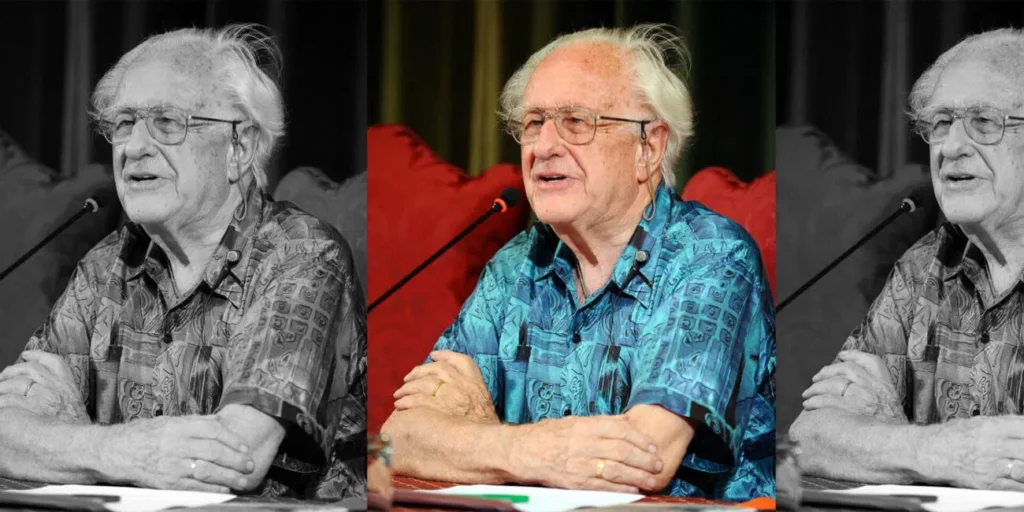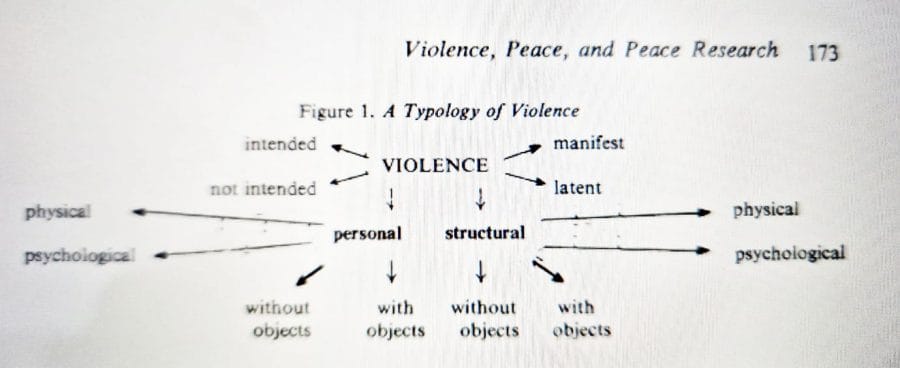A Personal Tribute to Johan Galtung (24 Oct 1930 – 17 Feb 2024): The Man for Just Peace
JOHAN GALTUNG MEMORIAL, 11 Mar 2024
Maung Zarni | FORSEA – TRANSCEND Media Service
“USA? I love the Republic, but I hate the Empire.” Galtung made unparalleled intellectual and practical contributions to the advancement of our understanding of peace, its social objectives and the conditions for peace, in terms of our global understanding of such an elusive goal.
4 Mar 2024 – On 17 February, Johan Galtung finally achieved his own personal peace.
Galtung died in a hospital in an Oslo suburb, in his native Norway in that wintery morning at 8 am, according to a special note from his devoted friend and closest associate Antonio C. S. Rosa who informed us the members of Transcend, Galtung’s peace activist network globally.
Tragically, the just peace for the oppressed which he so brilliantly explained in his decades-long scholarly works has remained ever elusive in the World Order managed primarily by corporate Men and Women of Profits, or “masters of mankind,” as Adam Smith called the 18th century English merchants with their outsized influence on the British state, and the corporate-subservient politicians who don’t view peace as an essential value for in running a state or formulating policies, much less “a way of life,” as Galtung would put it.
Exhibit A: What I call US-Israel joint genocide in Gaza, and the latter’s continuing colonial occupation of Palestine, which the western media misleadingly characterises as “conflict” or “war”. (Other examples abound, including Sudan, Syria, Myanmar, India, USA, and so on).
The old colonial Britain sowed, wittingly or not, the seeds of violence on the soil of Palestine, and the new imperial power of USA, which supplanted the former, picked up where the British Raj left off. Colonialism and imperialism were major topics which had concerned Galtung, who tasted the 5-years of life under the Nazi occupation of his native Norway, as much as me.
I am sharing my reflection on this intellectual and moral giant with whom I had the privilege of learning from and working with in the context of my own country Burma’s unceasing civil war, a legacy of 120-years of the British imperialist rule.
“USA? I love the Republic, but I hate the Empire,” said Johan Galtung, in his typically calm and confident voice responding to a question from the audience at his public lecture at St Antony’s College, Oxford. The year was 2007. This time Galtung was sharing his thoughts on the sustainability of the empire which, at the end of the Second World War, supplanted the British Empire and turned it into its poodle, namely the United States.
His lecture was on what he predicted as the coming fall of the United States as the global hegemon or Empire.
My friend and teacher in agrarian studies Barbara Harriss-White, then Head of Oxford University Department of International Development organized and hosted the renowned sociologist of peace and practitioner in the art of mediation, as the department’s distinguished speaker for its annual public lecture. Previous annual lecture was delivered by Noam Chomsky. I was an instigator behind Galtung’s lecture.
First a brief but relevant detour about my link to Galtung.
In the summer of 2003, I first met Professor Galtung in the home of my adopted North American sister Marilyn Langlois, at Richmond Point, by San Francisco Bay, a short drive from where US oil giant Chevron, her late scientist father’s employer, is headquartered.
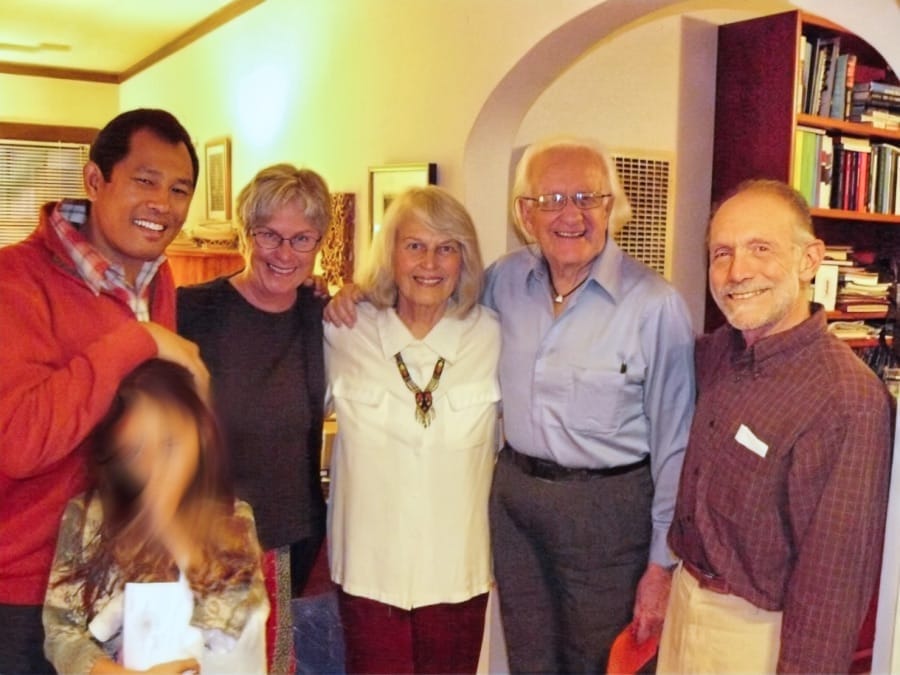
From left to right: Maung Zarni, his older daughter Dewi, Marilyn Langlois, Ingrid, Johan Galtung and Michael Nagler, Richmond, 2007
Both of us came from families – one Burmese and the other North American – with ties to violence, corporations and/or militarism, which may help explain our shared concern for peace and our high regards for Galtung, “the father of peace studies”. [On violence, Marilyn’s maternal aunt from Berkeley was Oppenheimer’s secretary at the Manhattan Project in Los Alamos during the World War II. And my extended family back in Mandalay have served in what has become a genocidal military of Burma over 3-generations since its inception under WWII Japan’s Fascist patronage].
As Barbara entertained suitable invitees for the post-Chomsky annual lecture for that year, I suggested “What about Galtung?” It was an easy sell, given how cross-cutting and influential Galtung’s work had been. During his long life of 93-years, Galtung had authored over 150 books in fields as diverse as peace and peace-making, security politics, violence, alternative defence, macro history, mathematics, peace journalism, future research, social science methodology, world order issues, economics and theory of science.
The public event was held at the main lecture theatre at St Antony’s College, Oxford. St Antony’s has a reputation among overseas students as an Establishment place, or more accurately, a recruiting ground for UK’s security services.
Provocatively titled something like the end of US Empire, Galtung’s lecture attracted the attention of some of the Establishment intellectuals from the college, including Timothy Garton Ash, Director of European Studies, who walked in the corridors of Euro-American powers. Several years later he appeared on Democracy Now! With Amy Goodman to explain his “the fall of US Empire” prediction.
I don’t remember exactly what the diabolical question which Garton Ash asked which solicited Galtung’s “USA?, I love the Republic, but I hate the Empire” response.
But suffice it to say, Galtung was not simply a technocratic theorist or expert on mediation in conflicts. His scholarship, public engagement and mediation efforts were transparently and uniformly anchored in his deeply held anti-imperialism, East or West.
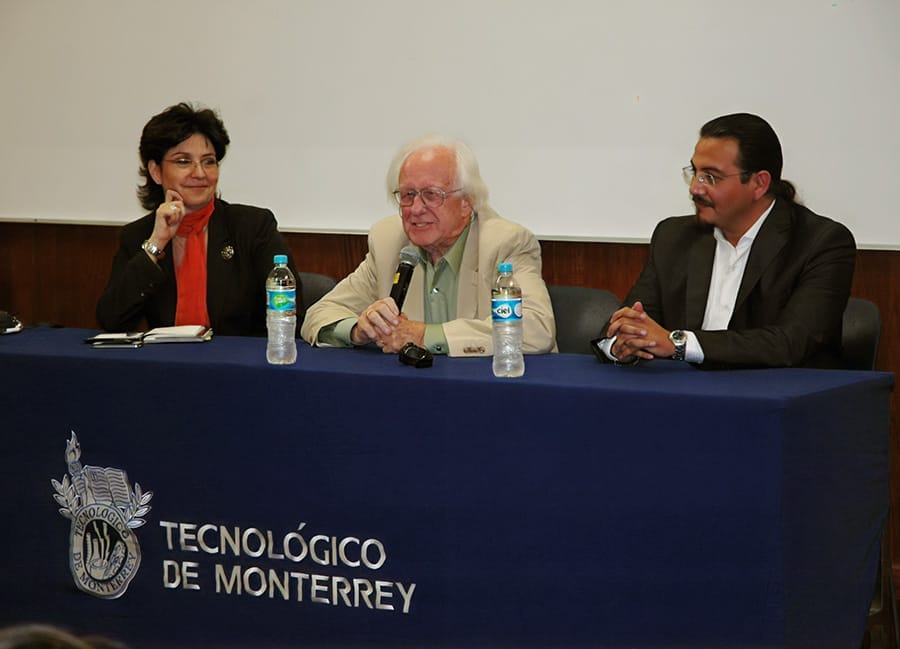
Galtung speaking at the Monterrey Institute of Technology and Higher Education, Mexico City in September 2012. Photo: Wikipedia Commons
In the lecture, Galtung boldly predicted the end of the US Empire. Ever the mathematician, he even came up with which decade (s), Pax Americana would end. In that connection, he reminded, with apparent pride, the audience that he was one of a handful of Soviet observers who predicted the fall of the USSR.
Galtung was born in the inter-war years in Norway, and had a taste of the Nazi occupation with the Quisling regime as its local Yo-Yo, which “invited” Hitler in. At 12, he saw his father arrested by the Gestapo in Norway.
Those in the Cold War West had typically characterised only the USSR, or “the evil empire,” as Ronald Reagan put it in his speech in West Berlin several years before the wall eventually came down in November 1989. They were generally taken aback when someone portrays the United States as a similarly evil empire, with millions of corpses on its track – not even in the closet.
The late Harold Pinter, the British Nobel Laureate in Literature, who, from his death bed, devoted half of his acceptance lecture Art, Truth and Politics to urging the world to start taking stock of the worldwide crimes of the United States while lamenting the absence of such stocktaking.
Indeed, towards other states, the United States typically conducts itself as a neo-totalitarian global hegemon, especially post-Cold War, with its signature “my way or highway” approach in world affairs, for instance, in Israel’s ongoing genocide in Gaza wherein even the fractured world come together to end the carnage.
As late as 21 February, 4 days after Galtung’s passing, the United States vetoed, for the 3rd time in 3 months, the Security Council resolution which called for the immediate ceasefire in Gaza, and to let the population on the verge of starvation eat – and live.
Galtung’s razor-sharp insights from 1960’s about the two types of violence, direct (person A physically harms person B, for instance) and indirect, that is built-in to the social/structural relations, remain perfectly applicable to the Gaza under Israel’s officially declared “total siege”. On the act of starving populations, Galtung writes, “the important point here is that if people are starving when this is objectively avoidable, then violence is committed, regardless of whether there is a clear subject-action-object relation, as during a siege yesterday …. (p.171).”
A decade before the president of the World Bank Dr Robert Mc Namara, the failed head of the Pentagon during the Vietnam War, announced “poverty” as the bank’s priority policy at the conference held in Nairobi – because US strategists identified “mass poverty” as the contributing factor behind the appeal of egalitarian ideologies such as socialism and communism – Galtung was developing his idea of multiple experiences of poverty as “structural violence”. In 1969, he published his seminal essay, framing, in effect, poverty as “structural violence”.
The North American officials still don’t get it when they talk about poverty (as income).
[For the advanced understanding of poverty see my old friend and housemate Sabina Alkire’s work on poverty as multiple dimensional beyond income @ Alkire-Foster Method | OPHI . So I was really delighted that Sabina had co-hosted a sumptuous Burmese for Johan and Fumiko during their brief stay in town for the QEH lecture. I cooked the meal, and Sabina baked the desert.]
In a similar vein, Washington again mis-identified “poverty” – not its ruthless, exploitative, and racist foreign policies – in the Middle East (and the greater Islamic world) as a driver of “terrorism” after 9/11.
In his paper entitled “Violence, Peace and Peace Research”, published in the Journal of Peace Research in 1969, Galtung introduced this concept of structural violence as “a form of violence wherein some social structure or social institution may harm people by preventing them from meeting their basic needs.”
Galtung explained how this violence – “without the actors” – operate to harm people in society. He writes:
“there may not be any person who directly harms another person in the structure. The violence is built into the structure and shows up as unequal power and consequently as unequal life chances. Resources are unevenly distributed, as when income distributions are heavily skewed, literacy/education unevenly distributed, medical services existent in some districts and for some groups only, and so on.’ Above all the power to decide over the distribution of resources is unevenly distributed. The situation is aggravated further if the persons low on income are also low in education, low on health, and low on power – as is frequently the case because these rank dimensions tend to be heavily correlated due to the way they are tied together in the social structure.”
On the real-life application of Galtung’s conceptual frameworks to economics and the decades-old “conflict” in the Palestine, Sydney University Professor Emeritus Stuart Rees wrote an eloquent tribute entitled “Death of a Giant for Peace: The Johan Galtung Legacy”, published on 29 February.
In his final months, Galtung must have been pained by what he witnessed virtually the total siege of Gaza’s 2.3 million people that Israel has been perpetrating both types of violence on population under siege, or “a nation under occupation”, as the father of the term genocide Raphael Lemkin would put it.
Post-Galtung world has most certainly witnessed Israel’s deadly mix of direct slaughter by sub-machine gun fire and the slow slaughter by starvation. Fortunately for Galtung, his death spared him the deep pain of knowing that the IDF tanks and soldiers, fired on Gazans who rushed to a rare aid convoy in order to get “flour” to feed families on the verge of famine. Israel’s direct and deliberate violence killed over 100 instantly, while having left 700 half-starved Gaza wounded.
As the world’s condemnations of genocidal violence got louder, all that the United States as the most influential financier of Israeli state terrorism is prepared to do is to offer the air-dropping of aid – not demand immediate ceasefire, for the besieged population of children, women, the wounded. Gazans will thus live another day, before the next round of Israel’s aerial bombardment or tank and artillery fire.
Galtung certainly saw through the fog of liberal propaganda – that US is a benign “empire of liberty” – that has, perhaps until 7 October, pervaded the views of the educated classes in USA and the Anglo-phone world, as well as the post-Holocaust Europe. As Galtung Q and A with Oxford’s Timonthy Garton Ash indicated he did not suffer such fools who bought into the Pavlovian view of benevolent Pax Americana with its “soft power”, spreading “European values of Enlightenment” such as democracy, human rights and liberal humanism globally.
Through his penetrating eyes, he saw the ugly workings of the United States, the one which, in reality, was operating behind “a million bayonets”. That was how George Orwell characterized his employer, the British Empire, in his 1st ever novel “Burmese Days.”
Certainly, Galtung did not fail to see the fact that, with unmatched war budget – officially “defence spending” – approaching one trillion $ per year, Washington maintains 750 military bases in 80 countries worldwide, including in his wife Fumiko Nishimura’s native Japan. Besides, Galtung would most definitely know that his native Norway was (and still is) a supplier, among other things, of certain Made-in-Norway components to US F-16 fighter-bombers. His fellow Norwegian humanitarian and professor of medicine Dr Mads Gilbert was openly exposing Norway’s role in the United States direct violence around the world. At the Students Peace Conferences held at the University of Tromso in the early 2000’s, I heard Professor Gilbert speak on the Norwegian contributions to global violence while giving out Nobel Peace prizes annually.
In our numerous conversations and exchanges, Galtung talked, with detectable distaste, of the political class that reign in his country as simply subservient to the diktats of the United States.
As if the political representatives on the Nobel Committee in Oslo reciprocated Galtung’s disdain for the Norwegian subservience to Washington, they had ignored the repeated nominations of Galtung for the prize while peace activists and scholars around the world sought out Galtung, the guru, his ideas as well as his company.

Johan Galtung, October 2023 Photo credit: (transcend.org)
Galtung exuded eternal optimism and bubbling energy, “eternal sunshine,” to put it poetically. A situation as dire and seemingly intractable as Palestine, Galtung would talk about his positive vision wherein all the Arabs and the Israeli can live in peace and equality. Not only was Galtung intellectually towering, but he was also a physically towering figure, with characteristic disarming laughs and smiles.
The last time I saw him was when he was holding Tun Mahathir Global Peace Chair at the International Islamic University in Kuala Lumpur in 2014. Alongside the moral and intellectual giants, including Gideon Levy of Israel, Denis Halliday of Ireland (who resigned from his position as UN Coordinator in Saddam’s Iraq, to protest the US sanctions that resulted in the death of hundreds of thousands of Iraqi children), Galtung spoke at the Conference which the former Prime Minister Mahathir Mohamad organized and hosted designed to mobilize public opinion to “criminalize war” – all wars.
We were in Rangoon together in the fall of 2005. It was during my short-lived, unsuccessful attempt at Track II mediation in my country of birth where we had reached a stalemate between Aung San Suu Kyi leadership and the ruling military regime. I arranged a one-on-one meeting for him to talk to the 3rd ranking Burmese general, who headed the country’s military intelligence services, about the possibilities of peace from TRANSCEND perspective.
The then British Ambassador Vicky Bowman put the Galtungs up in the ambassador’s residence colonially named “Balmoral” across the old War Office on Shwedagon Pagoda Road. At her arrangement, Galtung was also meeting with the country’s peace NGOs, run by a group of national minority representatives.
The Burmese military junta wanted to know if “the professor is our friend?” But Galtung was no friend of any party in conflict, little did they know. He was there to help mediate the conflict. The generals were seriously disturbed that Galtung would go and talk to the ethnic equality rights advocates. His mission was to talk everyone in the conflict. So, he naturally spent a day with those who wanted to rebuild the post-independence Burma of multiple ethnic nations as a “federalist” entity where every group had equal representation and an equal say in the way the country was governed. Paying lip service to “federalism”, the junta viewed any version of Burma other than effectively “unitary state”, as a formula for its disintegration.
Although 30-odd years senior to me in age and wisdom, I remember well how appreciative, eager and even respectful Galtung was in our interactions which involved him learning the specificities of Burma’s conflicts, which he wished to help resolve. Like all great educators, Galtung was not a one-way street “know-it-all” guru. Despite him being feted internationally as the “guru”, he was a lifelong learner and was humble enough to know that he still needed to learn from others, something that deeply impressed me.
Galtung made unparalleled intellectual and practical contributions to the advancement of our understanding of peace, its social objectives and the conditions for peace, in terms of our global understanding of such an elusive goal. The Norwegian Nobel Peace Committee’s refusal to recognize Galtung’s contributions to world peace and peace activism, or understanding of peace, as such, was both disappointing and disgraceful. That is, if we even take a glance at the list of the committee’s ignominious choices for this most prestigious recognition. Henry Kissinger, Likud’s Menachem Begin (whom Einstein called “terrorist” “Fascist”), Aung San Suu Kyi, Abiy Ahmed, or Barak Obama (with the daily “kill-list” over his White House breakfast table).
The neighbouring Sweden’s Right Livelihoods Foundation did at least honour the Scandinavian guru of peace with its Right Livelihoods Award in 1987. He was in good company with the likes of Amy Goodman of Democracy Now! of USA, the US National Intelligence Agency whistleblower Edward Snowden, and the renowned Buddhist teacher and activist Sulak Sivaraksa of Thailand, among others.
A quick Google search will cough up the incredible quantity of Galtung’s writings as well as practical contributions to peace and conflict research, including the establishment of scholarly journals and institutions including Peace Research Institute of Oslo (PRIO), which he founded in 1959 and directed until 1969. After OPRI, he held the world’s first endowed chair in peace studies at his alma mater, the University of Oslo for the following decade. (see the official obituary issued by OPRI here).
Besides his intellectual legacy as “the father of peace studies,” to many of us around the world, who see (just) peace, not simply as a political objective, but as a value to live and act upon, Galtung had gifted us with TRANSCEND Media Service, which collate important and thoughtful writings on peace and world affairs from variously anti-imperialist perspectives.
Naturally, on 17 February afternoon Antonio Carlos da Silva Rosa, Galtung’s friend and Portugal-based Editor and Compiler of TRANSCEND Media Service circulars, sent out the sad news that Galtung died at 8 am at a hospital in Oslo.
I wrote on my social media platform after reading Antonio’s sad and brief announcement.

I know that many of his friends, students, colleagues and acquaintances worldwide who had the privilege and honour of knowing Johan Galtung share my sentiment. One practical way to honour this great man would be to ensure that we keep his TRANSCEND network, with all its various components, alive through our own intellectual and financial contributions.
___________________________________________
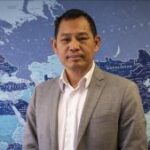 A Buddhist humanist from Burma (Myanmar), Maung Zarni is a member of the TRANSCEND Network for Peace Development Environment, former Visiting Lecturer with Harvard Medical School, specializing in racism and violence in Burma and Sri Lanka, and Non-resident Scholar in Genocide Studies with Documentation Center – Cambodia. Zarni s the co-founder of FORSEA, a grass-roots organization of Southeast Asian human rights defenders, coordinator for Strategic Affairs for Free Rohingya Coalition, and an adviser to the European Centre for the Study of Extremism, Cambridge. Zarni holds a PhD (U Wisconsin at Madison) and a MA (U California), and has held various teaching, research and visiting fellowships at the universities in Asia, Europe and USA including Oxford, LSE, UCL Institute of Education, National-Louis, Malaya, and Brunei. He is the recipient of the “Cultivation of Harmony” award from the Parliament of the World’s Religions (2015). His analyses have appeared in leading newspapers including the New York Times, The Guardian and the Times. Among his academic publications on Rohingya genocide are The Slow-Burning Genocide of Myanmar’s Rohingyas (Pacific Rim Law and Policy Journal), An Evolution of Rohingya Persecution in Myanmar: From Strategic Embrace to Genocide, (Middle East Institute, American University), and Myanmar’s State-directed Persecution of Rohingyas and Other Muslims (Brown World Affairs Journal). He co-authored, with Natalie Brinham, Essays on Myanmar Genocide.
A Buddhist humanist from Burma (Myanmar), Maung Zarni is a member of the TRANSCEND Network for Peace Development Environment, former Visiting Lecturer with Harvard Medical School, specializing in racism and violence in Burma and Sri Lanka, and Non-resident Scholar in Genocide Studies with Documentation Center – Cambodia. Zarni s the co-founder of FORSEA, a grass-roots organization of Southeast Asian human rights defenders, coordinator for Strategic Affairs for Free Rohingya Coalition, and an adviser to the European Centre for the Study of Extremism, Cambridge. Zarni holds a PhD (U Wisconsin at Madison) and a MA (U California), and has held various teaching, research and visiting fellowships at the universities in Asia, Europe and USA including Oxford, LSE, UCL Institute of Education, National-Louis, Malaya, and Brunei. He is the recipient of the “Cultivation of Harmony” award from the Parliament of the World’s Religions (2015). His analyses have appeared in leading newspapers including the New York Times, The Guardian and the Times. Among his academic publications on Rohingya genocide are The Slow-Burning Genocide of Myanmar’s Rohingyas (Pacific Rim Law and Policy Journal), An Evolution of Rohingya Persecution in Myanmar: From Strategic Embrace to Genocide, (Middle East Institute, American University), and Myanmar’s State-directed Persecution of Rohingyas and Other Muslims (Brown World Affairs Journal). He co-authored, with Natalie Brinham, Essays on Myanmar Genocide.
Tags: Biography, Johan Galtung, Obituary
DISCLAIMER: The statements, views and opinions expressed in pieces republished here are solely those of the authors and do not necessarily represent those of TMS. In accordance with title 17 U.S.C. section 107, this material is distributed without profit to those who have expressed a prior interest in receiving the included information for research and educational purposes. TMS has no affiliation whatsoever with the originator of this article nor is TMS endorsed or sponsored by the originator. “GO TO ORIGINAL” links are provided as a convenience to our readers and allow for verification of authenticity. However, as originating pages are often updated by their originating host sites, the versions posted may not match the versions our readers view when clicking the “GO TO ORIGINAL” links. This site contains copyrighted material the use of which has not always been specifically authorized by the copyright owner. We are making such material available in our efforts to advance understanding of environmental, political, human rights, economic, democracy, scientific, and social justice issues, etc. We believe this constitutes a ‘fair use’ of any such copyrighted material as provided for in section 107 of the US Copyright Law. In accordance with Title 17 U.S.C. Section 107, the material on this site is distributed without profit to those who have expressed a prior interest in receiving the included information for research and educational purposes. For more information go to: http://www.law.cornell.edu/uscode/17/107.shtml. If you wish to use copyrighted material from this site for purposes of your own that go beyond ‘fair use’, you must obtain permission from the copyright owner.
Read more
Click here to go to the current weekly digest or pick another article:
JOHAN GALTUNG MEMORIAL:
